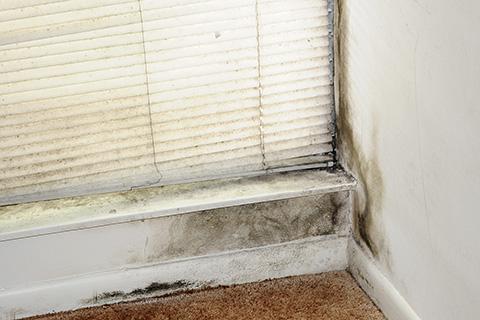The presence of household mold and its associated health risks are serious concerns for people living in regions with heavy rainfall. With the large amounts of rain recently drenching the Frederick area, your home may be at escalated risk of leaks, excess moisture, and mold.
Many common species of mold release airborne spores carrying toxins that have a wide range of health effects. According to the Centers for Disease Control and Prevention, most individuals experience irritation of the eyes, nose, and airways. The spores can be allergens, causing allergic reactions ranging from difficulty breathing to anaphylactic shock. People with asthma should be especially aware of mold, as the particles can also trigger an asthma attack.
The most common types of mold found in households are Cladosporium (olive green to black), Penicillium (white or green), Alternaria (dark-colored), Stachybotrys (commonly referred to as “black mold”), and Aspergillus (white, green, yellow, brown, or black). Cladosporium is the only one of the four that does not release toxins that can affect your health.
Mold is more likely to grow and cause harm when excess moisture is present. Often, it requires dead organic material with a water content of 70–90 percent, an ambient temperature of 40–100 degrees Fahrenheit, and oxygen. Mold can also grow on inorganic materials like plastics, metals, and concrete due to biofilms—thin layers of skin cells, grease, oil, food waste, etc.—that have developed. With the proper conditions, certain species can germinate in just four to 12 hours. Once an adequate environment is present, a mold spore will take root, hyphae (tiny filament chains of cells) will extend, and the mold will spread.
Preventing mold growth in your house is essential for your health and your family’s health. Roof, plumbing, and other leaks must be repaired as soon as possible to prevent the invasion and/or reappearance of mold. Appliances like air conditioners, washers, and dryers should be cleaned regularly and/or vented outside. Additionally, homeowners should keep their roof gutters unobstructed to prevent rainwater from settling in the foundation. Mold growth can be further prevented by reducing indoor humidity, such as opening a window while showering, cooking, dishwashing, and using a dehumidifier.
Nonetheless, if mold does appear in your house and is in a manageable location (no larger than 9 square feet) without electrical or structural hazards, you can perform the cleanup yourself using detergent or bleach diluted in water. The Environmental Protection Agency recommends the use of a dust mask, elbow-length gloves, and sealed goggles for your protection. Porous material cannot be cleaned and must be replaced because mold often spreads into the pores, making it nearly impossible to eliminate.
After the initial leak is repaired and dried, use the cleaning solution to scrub off the mold with a clean sponge. Make sure to dry the surface afterward to eliminate excess moisture and prevent the growth of new mold.


